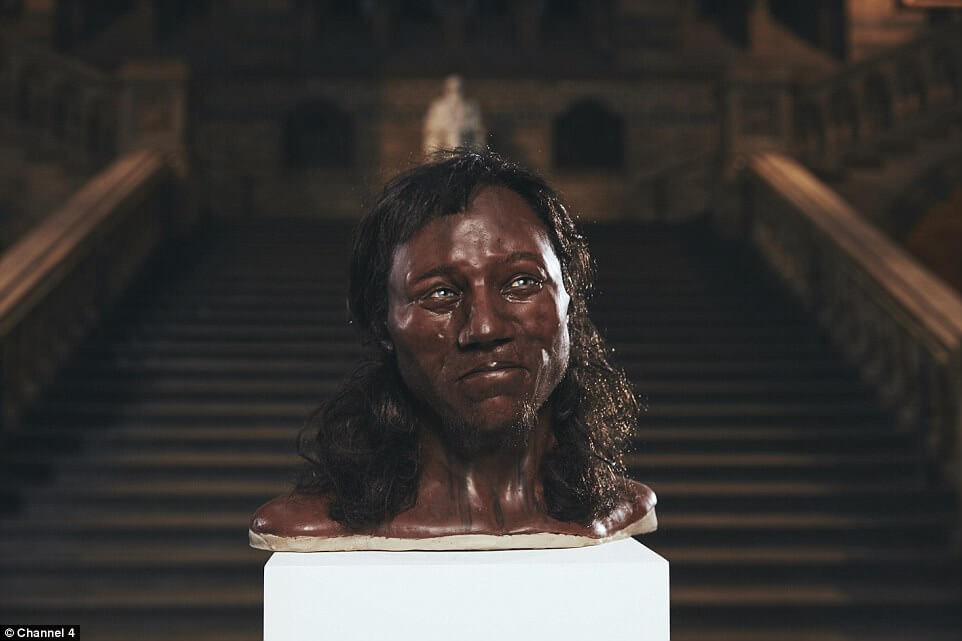
DNA analysis of the oldest complete skeleton in Britain, revealed that the first modern Britons, who lived approximately 10,000 years ago, had “dark to black” skin.
The fossil, also known as Cheddar Man, was unearthed over a century ago in Gough’s Cave in Somerset. Intense speculation has now built up around Cheddar Man’s origins and appearance, as he lived shortly after the first settlers came from continental Europe to Britain during the end of the last ice age. Even today, people who come from white ancestry, are descendants of that population. Combing human genome revealed roots of hair diversity.

Cheddar Man was believed to have pale skin and fair hair. However, his DNA draws a different picture, which strongly suggests that he had blue eyes, very dark brown to black skin and dark curly hair.

The discovery demonstrates that the genes for lighter skin became widespread in Europe`s populations far later than initially thought – and that skin color was not always a proxy for a geographic origin in the way it's often seen to be today.

Channel 4's documentary revealed the findings, tracking the ancient DNA project at London's Natural History Museum and creating a new forensic reconstruction of the head of Cheddar Man.

Museum scientists drilled a 2 mm-diameter hole in the ancient skull to obtain a few milligrams of bone powder. From that, they were able to extract a full genome, that held clues about the ancient relative’s appearance and lifestyle.

The findings pointed to a Middle Eastern origin, suggesting that Cheddar Man's ancestors left Africa, moved into the Middle East and then headed west into Europe, before they eventually crossed the ancient land bridge, Doggerland, which connected Britain to continental Europe. Nowadays, about 10% of white British ancestry could be linked to that ancient population.

Also, the analysis ruled out an ancestral link with people inhabiting Gough’s Cave 5,000 years earlier. Those individuals appear to have performed cannibalistic rituals, such as gnawing on human toes and fingers – probably after boiling them – or drinking from polished skull cups.

Britain was periodically settled and, later, cleared during ice ages until the last glacial period end approximately 11,700 years ago, since when it's been continuously inhabited.

Until now, however, it has not been clear whether each wave of migrants was seeded from the same population in Europe; the latest results suggest that this wasn't the case.

The scientists homed in on genes known to be linked to skin color, hair color and texture, and eye color. For skin tone, there are several genetic variants connected to lowered pigmentation, some of which are very widespread in European populations today. Nevertheless, Cheddar Man had “ancestral” versions of all those genes, which strongly suggests he would've had “dark to black” skin tone, but blue eyes.

Previous reconstruction of Cheddar Man, by the University of Manchester

When Cheddar Man's skull was scanned, a 3D model was produced by Dutch ‘paleo artists’ Alfons and Adrie Kennis, who make life-like reconstructions of early humans and extinct mammals



Cheddar Gorge was populated by cannibals about 14,700 years ago. They decapitated their dead, filleted their flesh and made cups from their skulls. Cheddar Man's DNA profile has revealed that although they were discovered in the very same cave, the Cheddar Man shares no direct ancestry with those earlier cannibals.
Scientists claim that populations living in Europe needed to produce enough vitamin D and that's why their skin tone gradually became lighter. Pale skin absorbs more sunlight! Recent findings suggest that pale skin might have emerged later, perhaps when the advent of farming meant that people were obtaining less vitamin D through dietary sources such as oily fish.
References: The Guardian, DailyMail













COMMENTS